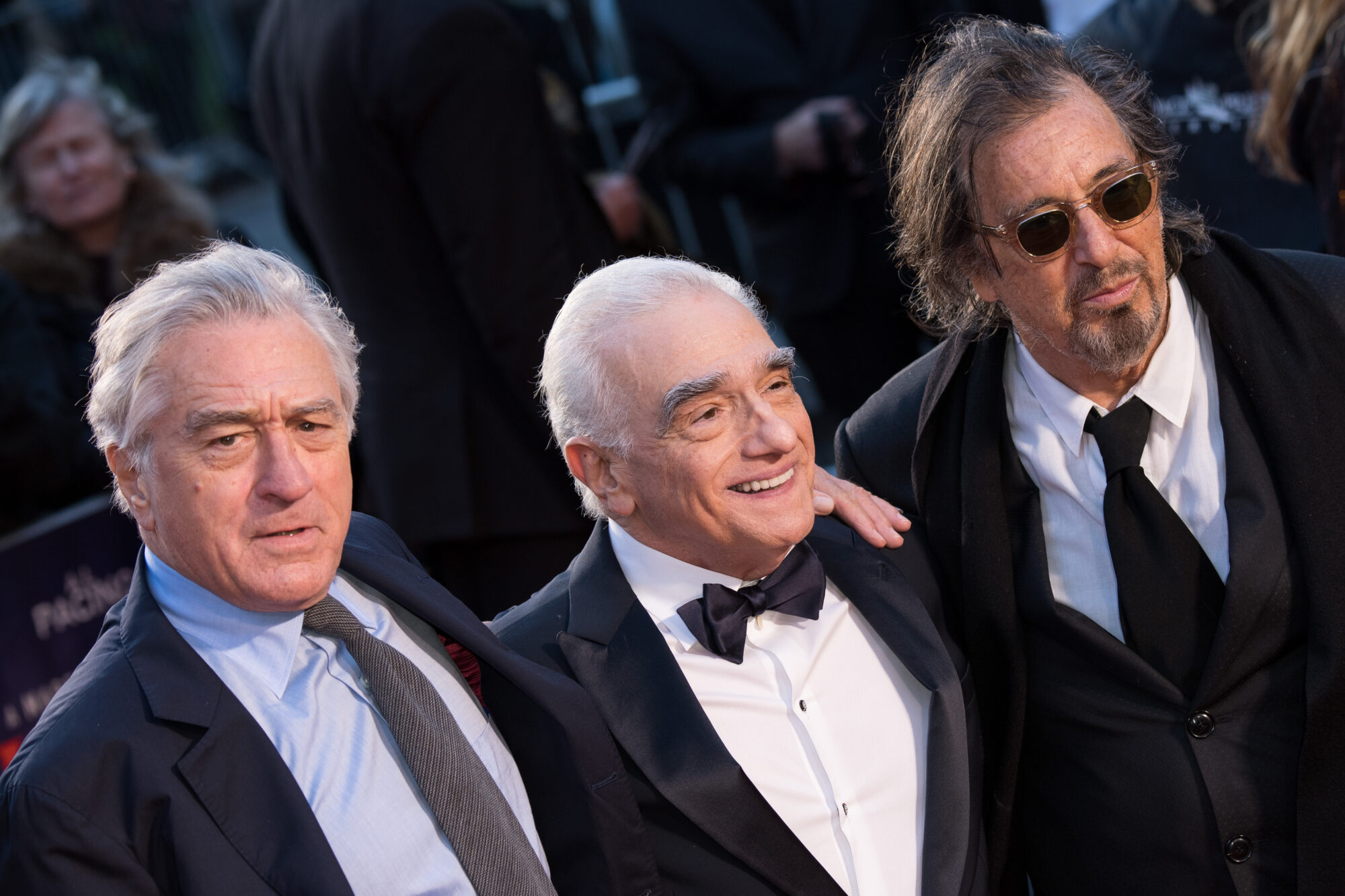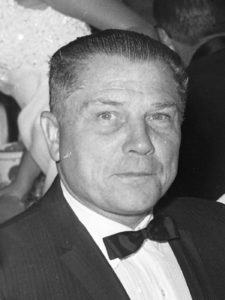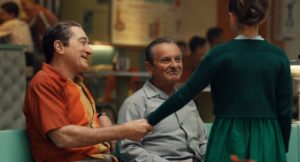Review: ‘The Irishman’ great film despite historical questions
Spirited debate over extent of Frank Sheeran’s involvement in Jimmy Hoffa murder does not significantly diminish Scorsese’s achievement

Martin Scorsese’s The Irishman is a great organized crime movie. It’s right up there with the director’s other great organized crime movies, including Goodfellas, Casino and The Departed. Nobody, and this includes Francis Ford Coppola, can touch Scorsese in this genre. His stories, most of them inspired by true events, have the look and feel and sound of authenticity. That’s certainly the case with The Irishman. You never encounter, during its three-and-a-half-hour run time, a false note that knocks you out of the narrative groove unfolding on screen.
One reason for Scorsese’s success is he works with great actors. In this case, the stars are Robert De Niro as Frank “The Irishman” Sheeran, Joe Pesci as Mafia boss Russell Bufalino and Al Pacino as Teamsters Union leader Jimmy Hoffa. A few other fine actors have small roles, but these three dominate the screen. And, of course, they are masters of their craft, all three probably top ten of all time in Hollywood history.
Another reason The Irishman works so well is the use of a cutting-edge technology that allows De Niro, Pesci and Pacino — all in their seventies — to look significantly younger in scenes where their characters are in young and middle adulthood. Whatever magic is behind this technology really works.
Finally, Scorsese’s success is due in no small part to working with excellent scripts. In the case of Goodfellas and Casino, the director benefited from the brilliance of Nicholas Pileggi. For The Irishman, Scorsese brought in Steven Zaillian, who is no slouch, having written the screenplays for Schindler’s List, American Gangster, Moneyball and Scorsese’s Gangs of New York. (Pileggi is associated with The Irishman as an executive producer.) Zaillian, no doubt with some expert input from Scorsese and others, has crafted a story line that is seamless and riveting without exaggeration or overreach. It’s also quite funny in places.

Zaillian’s script is based on a book by Charles Brandt called I Heard You Paint Houses. The book is based on Sheeran’s confession near the end of his life that he killed Hoffa. The book is controversial because journalists who have obsessed over solving the Hoffa case for more than forty years do not believe Sheeran’s story. They believe Sheeran decided to claim personal responsibility for Hoffa’s demise in order to sell books and thereby leave some money for his family.
As journalists Dan Moldea, Vince Wade and others point out, one could get whiplash from following the changing story that Sheeran told in his final years. (Sheeran died in 2003.) But Sheeran’s critics have the unfortunate task now of having to prove that he DIDN’T do it. Thanks to the power and reach of cinema, the storyline of The Irishman will, sadly, become the public’s default understanding of what happened to Hoffa.
Which is very unfortunate, because it is highly unlikely that The Irishman gets the story right.
Everyone agrees that Sheeran was in Detroit at the time of Hoffa’s disappearance on July 30, 1975. (He was there to attend the wedding of William Bufalino’s daughter.) And some investigators even acknowledge Sheeran could have been in the car with Hoffa as he left the Machus Red Fox restaurant, never to be seen again.
What the controversy comes down to is who pulled the trigger. Sheeran says he did. Others insist a New Jersey hitman named Salvatore “Sally Bugs” Briguglio did the deed. Most investigators and journalists who have researched the case believe Sally Bugs was the shooter. Most recently, in a Fox News report, Phil Moscato Jr., son of a late Genovese crime family associate, identified Briguglio as Hoffa’s assassin.
Briguglio himself never had a chance to tell his story to the FBI or the press. In 1978, he was shot to death on Mulberry Street in New York’s Little Italy neighborhood. It was clearly a Mob hit, intended to prevent Briguglio from talking to the feds.
How the Hoffa assassination went down is also at issue. Sheeran said there were three people in the car with him: Hoffa, Chuckie O’Brien and Briguglio. He said he and Hoffa got out of the car in front of a Detroit home, and O’Brien and Briguglio drove off. When they entered the house, Sheeran shot Hoffa two times, killing him. Sheeran says Hoffa’s body was cremated.
Others say Sheeran was not in the car at all, and that when Hoffa got in, either Briguglio or another mobster, Thomas Andretta, knocked Hoffa out with the butt of a gun. After that, Hoffa was either strangled or shot to death, after which his body was turned over to someone else and it was cremated.
What exactly happened to Hoffa’s body remains an open question. Some believe his body was not cremated, and that it was shipped in a fifty-five-gallon drum to a dump in New Jersey. Others wonder why his body would be transported such a long distance when members of the Detroit Mafia could have effectively disposed of it closer by.
On December 11 at The Mob Museum, veteran journalists Dan Moldea, Eric Shawn and Vince Wade will dissect the Hoffa mystery, separating fact from fiction in pursuit of what really happened on July 30, 1975. Click here to RSVP.
On a more positive note, aside from what happened on July 30, 1975, the basic bones of the Sheeran story as told in The Irishman are fairly solid.
Although not as well known as other Mafia bosses of the era, Bufalino, dubbed “The Quiet Don,” was in fact a top-level crime boss with a reach far beyond his home territory of northeastern Pennsylvania. He and Sheeran met in 1955, and Bufalino brought Sheeran into his crime family. Sheeran, a large man who saw a significant amount of combat during World War II, was capable of violence and murder on behalf of Bufalino.
As for Hoffa, he was one of the most powerful men in the country as president of the Teamsters Union. When he started serving a prison term in 1967, Hoffa remained president of the union, but he appointed a lieutenant, Frank Fitzsimmons, to handle things while he was behind bars. Fitzsimmons proved to be very amenable to the Mob’s wishes.
In 1971, while still in prison, Hoffa was prevented from running for re-election. Fitzsimmons ran and won. After President Richard Nixon commuted Hoffa’s sentence in December 1971, Hoffa was determined to regain the Teamsters presidency. The Mob was less enthusiastic. As Hoffa agitated for a return to power, Bufalino and other Mafia bosses determined he was causing too much trouble and had to be eliminated.
Hoffa and Sheeran became close after Bufalino introduced the two. Sheeran got involved with Teamsters organizing and eventually became president of a Teamsters local in Delaware. Hoffa, who didn’t trust many people, trusted Sheeran.
According to Sheeran’s account, when push came to shove, and Bufalino decided Hoffa had to go, Sheeran’s long-standing loyalty to the Mafia boss took precedence over his friendship with Hoffa.

These relationships are all effectively recounted in The Irishman. To this extent, the movie does a good job of dramatizing one of the most significant narratives in twentieth century Mob history. There’s even a brief scene showing the key role the Teamsters Union played in financing the Mob’s construction of Las Vegas casinos from the late 1950s through the early 1970s.
The Irishman has been compared with Oliver Stone’s JFK on grounds that moviegoers will, to the dismay of journalists and historians, believe these films to be historically accurate. But the comparison may be a little unfair to The Irishman.
The story told in JFK, based on the wild speculations of New Orleans district attorney Jim Garrison, had been discredited long before the movie was made. Those who believe that JFK explains the assassination of President John F. Kennedy have fallen victim to one of the all-time-worst cases of “fake news.” JFK is built on a flimsy foundation of lies.
In the case of The Irishman, the foundation is a little sturdier. There is near-consensus that Bufalino called the hit on Hoffa. If so, Sheeran was likely involved in some way. The major contention is which individual involved in the conspiracy actually pulled the trigger on that fateful day. The best information says Briguglio did it, not Sheeran, but it is difficult to prove.
Of course, we want to know who did it, and maybe someday more evidence will emerge to help solve this mystery. Journalists and historians continue to dig for answers. In the meantime, we have The Irishman, which places the gun firmly in Sheeran’s hand. While this is understandably frustrating for researchers, it does not significantly diminish Scorsese’s cinematic achievement.
Feedback or questions? Email blog@themobmuseum.org





